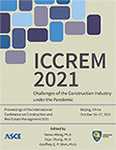Literature Characteristics and Knowledge Graph Analysis of Credit Construction Research in Domestic Construction Industry
Publication: ICCREM 2021
ABSTRACT
In this paper, 128 literatures related to credit construction in construction industry published from 2000 to 2020 are retrieved from CNKI database as the research object. EndNote and CiteSpace are used to analyze the literature characteristics and visual knowledge graph of credit construction in construction industry. It also reveals the research hotspots and development trends of credit construction in domestic construction industry. This paper finds that the research on credit construction of construction industry is in a state of fluctuation and shows a weak upward trend in the past two years. It also finds that the research hotspots include construction market, credit evaluation, credit system, lack of credit, credit mechanism, index system, etc.
Get full access to this article
View all available purchase options and get full access to this chapter.
REFERENCES
Cao, D. Y., and Lu, Y. (2007). “The credit evaluation of the construction contractor to the owner.” Seeker, (03), 35–36+214. (in Chinese).
Chen, Y., Chen, C. M., Liu, Z. Y., Hu, Z. G., and Wang, X. W. (2019). “The methodology function of Cite Space mapping knowledge domains.” Studies in Science of Science, 33(02), 42–253. (in Chinese).
Chen, Y. Y., Wang, X. Q., Sun, H., and Liu, B. S. (2014a). “Research on credit evaluation index system of qualified personnel in construction market.” Journal of Tianjin University (Social Science Edition), 16(03), 228–232. (in Chinese).
Chen, Y. Y., Wang, X. Q., and Wei, Z. (2014b). “Construction contractor credit evaluation model based on binary semantics.” Fuzzy Systems and Mathematics, 28(01), 98–105. (in Chinese).
Ding, J. (2004). “A probe into the credit of China’s construction industry.” Construction Economy, (04), 28–30. (in Chinese).
Fan, Z. Q., Wang, X. Q., and Li, B. L. (2009). “Evaluation of construction market participator of practicing qualification based on matter-analysis theory.” Soft Science, 23(07), 41–45. (in Chinese).
Feng, J. C., Tao G. W., Fei, K., Feng, H., and Li M. (2019). “Research on test model of credit of construction market subjects.” Science and Technology Management Research, 39(16), 251–256. (in Chinese).
Hao, S. Y., and Liu, Y. M. (2005). “Countermeasures against default payment problems in China’s construction sector.” China Soft Science, (05), 83–88. (in Chinese).
Hou, J. H., and Hu, Z. G. (2013). “Review and prospect of CiteSpace software application research.” Modern intelligence, 33(04), 99–103. (in Chinese).
Liu, C., Lv, G., and Lai, J. Y. (2018). “Credit evaluation model research of construction enterprises based on sem.” Journal of Civil Engineering and Management, 35(01), 146–151+163. (in Chinese).
Liu, G. J., and Zhu, Y. (2005). “Credit evaluation of construction companies based on data mining.” Journal of China University of Mining & Technology, (04), 494–499. (in Chinese).
Meng, B., Yang, Y., and Diao, S. J. (2019). “Research on credit evaluation model of small construction enterprises based on distinguishing two types of customers.” Systems Engineering Theory and Practice, 39(02), 346–359. (in Chinese).
Meng, X. H. (2000). “Research on international engineering insurance system for reference.” Construction Economy, (08), 10–13. (in Chinese).
Su, S. Q. (2000). “On strengthening the rule of law in construction market.” South China Journal of Economics, (11), 23–24. (in Chinese).
Sun, J. R. (2020). “Research on the establishment of credit management platform in the construction market based on blockchain technology.” Construction Economy, 41(07), 112–117. (in Chinese).
Sun, P., Shi, H. Q., and Ni, L. F. (2006). “Research on the credit standard system of construction enterprises based on the method of AHP.” Construction Economy, (S1), 40–42. (in Chinese).
Wang, J. Y. (2002). “Implement the engineering guarantee system to standardize the economic activities of construction.” Construction Economy, (06), 17–18. (in Chinese).
Wang, M. J., Peng, B., and Chen, H. H. (2006). “Research on credit system in construction market based on system dynamics.” Journal of Systems & Management, (05), 409–411. (in Chinese).
Wang, X. Q., Zhu, L. N., and Yang, Q. B. (2013). “Evolutionary game analysis of untrustworthy behavior in the process of construction market supervision.” Journal of Guangxi University (Natural Science Edition), 38(01), 202–207. (in Chinese).
Wu, Y. N., Lin, P., and Chen, W. J. (2010). “Evaluation of construction-agency credit based on the improved TOPSIS model.” Journal of Central South University(Social Sciences), 16(06), 75–82. (in Chinese).
Xin, L. Q., and Bao, X. J. (2020). “Research on credit risk evaluation of construction listed companies: based on logistic model.” Construction Economy, 41(10), 98–101. (in Chinese).
Yan, W. Z., and Liu, C. J. (2004). “Research on the settlement mechanism of project arrears and migrant workers’ wages in the field of construction.” Journal of Socialist Theory Guide, (07), 52–54. (in Chinese).
Yang, Y. H. (2005). “Analysis and institutional thinking on the causes of arrears of project payment and migrant workers’ wages in construction industry.” Enterprise Economy, (08), 112–114. (in Chinese).
Yuan, H. X., and Wang, X. Q. (2014). “Comprehensive evaluation of registered builders’ professional credit based on fuzzy matter-element theory.” Industrial Engineering, 17(01), 66–71. (in Chinese).
Zhang, K., Liang, Y. Q., Xue, S., and Hu, L. C. (2018). “Weight calculation of credit evaluation of construction enterprises from the perspective of cross correlation.” Statistics and Decision, 34(10), 178–182. (in Chinese).
Zhang, Y. C., and Wang, M. J. (2008). “Credit mechanism research of construction market.” Standard Science, (10), 49–52. (in Chinese).
Zhu, H. L., and Cao, X. Y. (2000). “Liability for fault in contracting in bidding for construction projects.” Construction Economy, (03), 27–29. (in Chinese).
Information & Authors
Information
Published In
Copyright
© 2021 American Society of Civil Engineers.
History
Published online: Dec 9, 2021
Authors
Metrics & Citations
Metrics
Citations
Download citation
If you have the appropriate software installed, you can download article citation data to the citation manager of your choice. Simply select your manager software from the list below and click Download.
